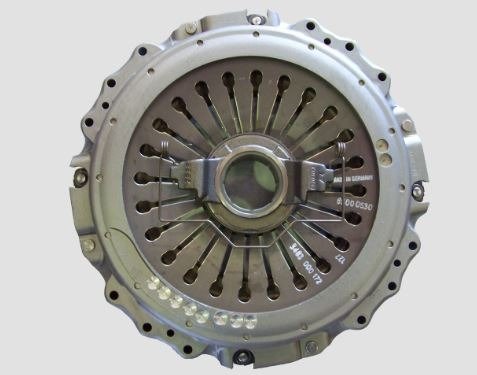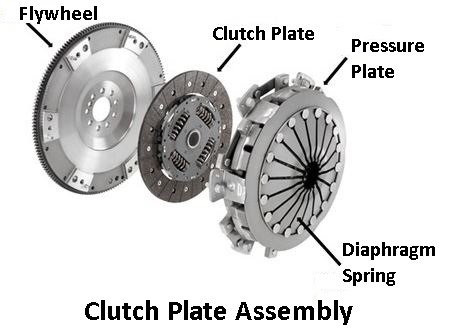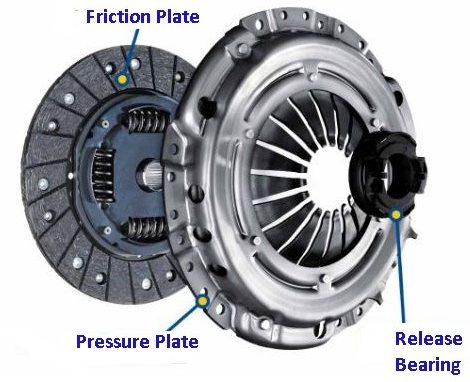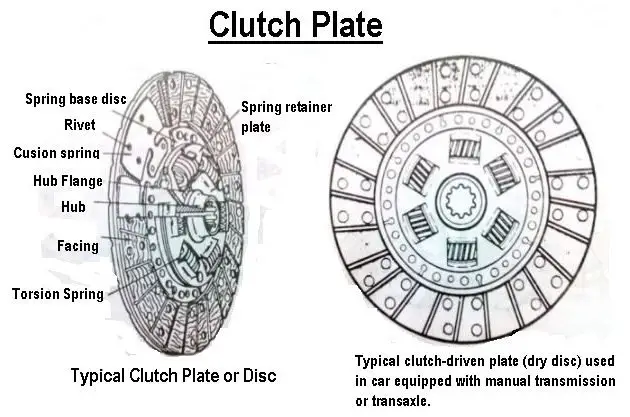In this article, we will discuss what is a clutch? its working principle, parts, the requirement of the clutch in the engine, and clutch plate or disc.
What is a Clutch?
A clutch is a mechanical device used in the transmission system of a vehicle. It engages and disengages the transmission system from the engine. It is fixed between the engine and the transmission.
The power produced inside the engine cylinder ultimately aims to turn the wheels so the vehicle can move on the road. The reciprocating motion of the piston rotates a crankshaft by rotating the flywheel through the connecting rod.

The circular movement of the crankshaft is now to be transferred to the rear wheels. It is transmitted through the clutch, gearbox, universal points propeller shaft or driveshaft, differential, and axles extending to the wheels.
With the help of all these parts, the use of engine power for the driving wheel is called power transmission. The utilization of engine power to the driving wheels through all these parts is called power transmission.
The power transmission system is normally the same on all passenger cars and trucks. But its design and arrangement may vary according to the method of drive and type of transmission units.
Read also: 9 Different Types of Clutches
Parts of a Clutch
The following are the main parts of a clutch:

Flywheel
The flywheel functions as an energy storage component, storing excess power and releasing it back into the system as needed. It usually connects to the crankshaft and keeps turning while the engine is running.
Friction Disc
These discs are attached to the driven shaft and are essential in allowing the driven and driving shafts to change directions. The friction created between the discs helps in the transfer of power.
Pressure Plate
The most important component of the entire clutch assembly is the pressure plate. It applies a clamping force (pressure) to the driven friction disc which holds it between it and the flywheel. The pressure plate is bolted to the flywheel and rotates together.
Clutch Plate
The friction between the pressure plate and the flywheel plate causes the clutch plate to spin together with the flywheel, which rotates the shaft and the attached transmission.
Spring and Release Lever
In clutches, diaphragm springs are often used to supply the required spring force. These springs are operated by levers.
The force applied to the spring during clutch disengagement is significantly reduced by the release lever. The clutch mechanism can be smoothly disengaged by pulling the release lever, which lowers the stress on the diaphragm spring.
Release Bearing
Clutch release bearings are utilized to transfer or limit the driving force. The high-speed rotating diaphragm spring exerts a tremendous force on the clutch release bearing when the driving force is cut off, causing the bearing to rotate rapidly.
Diaphragm Spring
The diaphragm spring, being one of the key components of the clutch, produces pressure force for the clutch. It also allows for clutch engagement and disengagement. Diaphragm springs are dynamically loaded while they are operating.
Linkage
A clutch linkage mechanism transfers power from the pedal to the fork by use of a set of levers and rods. Pressing the clutch pedal causes the pushrod to turn, which in turn pushes the bell crank and reverses the movement of the pedal.
How Clutch Works in a Vehicle
Clutch is a mechanical device used in the transmission system of a vehicle. It engages and disengages the transmission system from the engine. It is fixed between the engine and the transmission.

- When the clutch is engaged, the power is transmitted from the engine to the driving wheels through the transmission system and the vehicle starts moving.
- When the clutch is disengaged, the power is not transmitted to the rear or driving wheels and the vehicle stops while the engine is still running.
- The clutch is disengaged when starting the engine, when stopping the vehicle, when shifting the gears, and when idling the engine.
- The clutch is engaged when the vehicle is to move and is kept engaged when the vehicle is moving. The clutch also allows the continuous taking up of the load.
When properly operated, it prevents the jerky motion of the vehicle and thus avoids putting undue strain on the remaining parts of the power transmission system.
Read also: Torque Converter: It’s Working Principle & It’s Parts
Working Principle of Clutch
The clutch works on the principles of friction, when two friction surfaces are brought in contact with each other and pressed they are united due to the friction between them. If one is revolved, the other will also revolve.
The friction between the two surfaces depends upon the area of the surfaces, the pressure applied upon them and the coefficient of friction of the surface materials, The two surfaces can be separated and brought into contact when required.
One surface is considered as a driving member and the other as a driven number. The driving member is kept rotating when the driven member is brought in contact with the driving member, it also starts rotating. When the driven member is separated from the driving member it stops revolving. This is how a clutch operates.
The friction surfaces of the clutch are so designed that the driven member slips on the driving member when the pressure is first applied. As pressure increases the driven member is brought slowly to the speed of the driving member.
When the speeds of the members become equal, there’s no slip, the two members are in firm contact and the clutch is now fully engaged.
The driving member of a clutch is the flywheel. It is mounted on the crankshaft the driven member is the pressure plate. This is mounted on the transmission shaft. The clutch plates are between the two members.
When the clutch is engaged, the engine is to the rear wheels through the transmission system. When the clutch is disengaged by pushing the clutch pedal, the engine is disconnected from the transmission. Thus, the power stops flowing to the rear wheels while the engine is still running.
Clutch Plate or Disc
The clutch plate is the driving member of the clutch and is gripped between the flywheel and the pressure plate. It is mounted on the clutch shaft through the splines. When it is gripped, rotates the clutch shaft and the power is transmitted from the engine to the transmission through the clutch.

A pressure plate consists of two sets of facing or friction material mounted on steel cushion springs. The facing and cushion springs are riveted to a spring base disc and spring retainer plate which are slotted for the insertion of the torsion spring.
These springs contact the hub flanges that fit between the spring retainer plate and the disc and serve to transmit the twisting force applied to the facings to the splined hub. The spring action serves to reduce torsional vibrations and shocks between the engine and the transmission during clutch operation.
The facing and the plates rotate with respect to the hub to the limit of the compression of the springs or to the limit of the spring stops.
When the clutch is engaged, the pressure on the facing compresses the cushion springs sufficiently to cause the unit to decrease in thickness by 1 to 1.5 mm. This construction helps to make engagement smooth and chatterless.
Types of Clutch
Following are the common types of clutches:
Single Plate Clutch
A single-plate clutch is made up of one clutch plate and operates on the basis of friction. It is a type of friction clutch used in cars to engage and disengage power transmission. It works by sandwiching a single friction plate between the flywheel and the pressure plate.
Multi-plate Clutch
A multi-plate clutch is a mechanical device used in automobiles to transfer power from the engine to the transmission. It is a very efficient and dependable clutch that uses multiple friction plates to engage and disengage the power flow.
Cone Clutch
A cone clutch functions similarly to a disk or plate clutch, except it employs two conical surfaces to transfer torque through friction rather than connecting two spinning disks. Nowadays, cone clutches are often limited to low-peripheral speed applications.
Centrifugal Clutch
A centrifugal clutch is a type of automatic clutch that operates using centrifugal force. At lower rotating speeds, the output shaft is disengaged; once the output reaches a particular speed, it engages. It’s commonly utilized in mopeds, underbones, lawnmowers, go-karts, chainsaws, small motorcycles, paramotors, and boats.
Positive and Spline Clutch
A positive clutch system has grooves carved into either the driving or driven member, with designed components situated in both. These specific components mesh with the grooves when the driver depresses the clutch pedal, resulting in the driving and driven shafts spinning together.
On the other hand, these components come out of the grooves when the driver depresses the clutch pedal, which causes the driven shaft and engine shaft to rotate separately.
Friction Clutch
A friction clutch is one in which surfaces linked to the driving and driven shafts create friction, which transfers drive. These surfaces are coated with cork, asbestos, or another fibrous material. Friction clutch linings in automobiles must be updated on a regular basis.
Hydraulic Clutch
A hydraulic clutch mechanism employs a hydraulic line rather than a mechanical connection to transfer the pedal movement. When the clutch is engaged on the gearbox, a piston on the master cylinder at the pedal sends pressure through a fluid to the piston on the slave cylinder.
This clutch is classified into two types based on its design: Hydraulic Torque Converter and Fluid Coupling.
Semi-Centrifugal Clutch
In addition to the standard parts of a centrifugal clutch, a semi-centrifugal clutch also includes a pressure plate and a weighted lever. The weighted lever does not come into contact with the pressure plate when working at low speeds because the clutch springs stay engaged.
This setup makes clutch engagement and disengagement efficient, especially in stressful situations like racing or high-performance driving.
Diaphragm Clutch
The diaphragm clutches use diaphragm springs in place of coil or helical springs. Diaphragm clutches, in contrast to other kinds, don’t need additional release levers because the diaphragm spring doubles as a set of levers.
The diaphragm spring’s design makes it useful for providing the force required for clutch engagement and disengagement, eliminating the need for other mechanical parts.
Vacuum Clutch
The suction stroke of the engine creates a vacuum, which powers a vacuum clutch linkage. It consists of a vacuum reservoir tank that is linked by a non-return valve to the engine’s inlet manifold.
Electromagnetic Clutch
These clutches use an electromagnetic field to transmit power. Electromagnetic clutches include magnetic particle clutches, magnetic hysteresis clutches, and eddy current clutches.
Read Also: Different Types of Clutches and Their Uses
The Requirement of a Clutch
The following are the main requirements of a clutch:
- The clutch should be able to transfer maximum torque to the engine.
- The clutch should engage gradually to avoid sudden jerks.
- It should be able to dissipate a large amount of heat that is generated during the clutch operation due to friction.
- The clutch should be dynamically balanced. This is especially required in the case of high-speed engine clutches.
- The clutch should have a suitable mechanism to dampen vibrations and eliminate the noise produced during the power transmission.
- To save as much space as possible, the clutch should have the smallest possible size.
- To reduce effective clamping load on the carbon thrust bearing and wear on it. The clutch should have a free pedal play.
- The clutch should be easy to operate requiring as little effort as possible on the part of the driver.
- The driven member of the clutch should be built as light as possible so that it will not continue to rotate for any time after the clutch has been disengaged.
Closing It Up
That’s it. Thanks for reading. If you like our article on clutch share it with your friends. If you have any questions about the “working principle of clutch” leave a comment.
Want free PDFs direct to your inbox? Then subscribe to our newsletter.
Download PDF of this article:
Read more in our blog:
Great article! I learned a lot about clutch plates and how they work.
I’m glad it was helpful for you. Keep visiting.
Very interesting. .
Can you I a pdf.
Thanks.
Thanks for reading. The PDF file has been sent to your inbox.
Nice
Thanks.
Thanks for this article.
You’re welcome 🙂
I preferred to have more about this thanks very much this